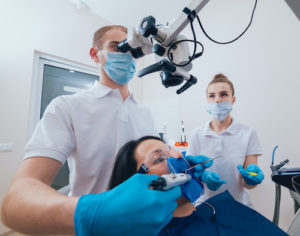Tooth extraction is a procedure in which a tooth is removed from a patient’s mouth. Also sometimes called tooth removal, this process often occurs during adulthood. Many dentists use it to address a tooth impaction, such as when wisdom teeth do not fully emerge through the gum line.
removal, this process often occurs during adulthood. Many dentists use it to address a tooth impaction, such as when wisdom teeth do not fully emerge through the gum line.
Tooth Extraction: A Common Adult Dental Procedure
While removing a wisdom tooth is one of the most common reasons for tooth extraction, there are numerous other reasons why a dentist might recommend this step. These include the following:
- Tooth infection
- Crowding among teeth
- Teeth shifting because of braces
- Compromised teeth in patients with chronic or serious health conditions
- Excessive tooth decay
- Impacted tooth
- Broken tooth
Who Can Perform a Tooth Extraction?
Depending on the circumstances, a dentist may be able to perform tooth extractions. In general, this type of surgery takes place right in the dental office using anesthesia.
For more complex cases, an oral surgeon might be a better option. A patient who has impacted teeth, broken teeth or teeth below the gum’s surface are a few examples of those cases that are more involved.
Types of Tooth Extractions
There are two primary types of teeth extractions:
- Simple extraction: This procedure tends to be limited to those teeth easily seen by the dentist. The patient is given a local anesthetic so that the areas around the affected tooth are numbed. Instead of feeling pain during the extraction, the patient will feel only pressure. First, the dentist uses a specialized instrument known as an elevator to loosen the affected tooth sufficiently. Forceps are then used actually to remove the tooth.
- Surgical extraction: A surgical extraction is typically the procedure that is performed on patients who have an impacted tooth, broken tooth, or another complex case. In most cases, patients will receive a combination of local anesthesia to numb the area and intravenous anesthesia to make them feel relaxed and calm. For some patients, general anesthesia could be called for, depending on any medical conditions that exist. Once the patient has been given the suitable anesthesia, the dentist makes a small incision in the gum. Sometimes the tooth must be cut or bone removed before the tooth can be successfully extracted.
What is a Dry Socket?
Like any medical procedure, tooth removal can result in side effects. One of these is called a “dry socket.” In most cases, a blood clot forms in the bone’s hole where the tooth was previously located.
Sometimes, the blood clot becomes dislodged, or it does not form at all. This leaves the socket exposed. The dentist treats dry socket by placing a dressing over the area for a few days.
While the dentist or oral surgeon will provide the patient with after-surgery instructions, the following risks are ones to work out for:
- Redness and/or swelling at the site of the extraction
- Nausea
- Severe chills and fever
- Cough
- Bleeding that doesn’t stop after 12 hours
- Shortness of breath
- Vomiting
- Chest pain
Recovering From a Tooth Extraction
For most people, recovering from teeth extractions takes a few days. Using an ice pack on the affected area, keeping the gauze in place for several hours, and taking medications as prescribed are typical instructions that help speed up recovery.
For patients who have questions or concerns after a tooth extraction, contacting their dentist is a good idea. At Lovett Dental Pasadena, we love to hear from our patients!
If you are having pain, swelling, or another issue, we encourage you to contact us at 281-998-8800. Our compassionate and professional staff is here to serve our patients by providing you with the best dental care.
